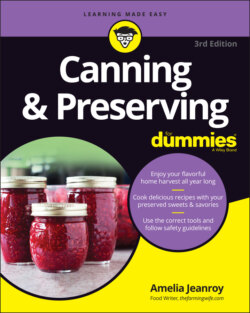Читать книгу Canning & Preserving For Dummies - Amelia Jeanroy - Страница 66
Key equipment for water-bath canning
ОглавлениеJust as you wouldn’t alter the ingredients in a recipe or skip a step in the canning process, you don’t want to use the wrong equipment when you’re home-canning. This equipment allows you to handle and process your filled jars safely.
The equipment for water-bath canning is less expensive than the equipment for pressure canning (check out Chapter 9 to see what equipment pressure canning requires). Water-bath canning kettles cost anywhere from $25 to $45. You may want to purchase a “starter kit” for about $50 to $60, which includes the canning kettle, the jar rack, a jar lifter, a wide-mouth funnel, and jars.
Following is a list of the equipment you must have on hand, no exceptions or substitutions, for safe and successful water-bath canning.
A water-bath canner: The water-bath canner consists of a large kettle, usually made of porcelain-coated steel or aluminum, that holds a maximum of 21 to 22 quarts of water, has a fitted lid, and uses a rack (see the next item) to hold the jars (see Figure 4-1). Do not substitute a large stock pot for a water-bath canner. It is important for the jars to be sitting off the bottom of the canner, and racks that fit this purpose are included in your canner kit. Although aluminum is a reactive metal (a metal that transfers flavor to food coming in direct contact with it), it’s permitted for a water-bath canner because your sealed jar protects the food from directly touching the aluminum.
A jar rack: The jar rack for a water-bath canner is usually made of stainless steel and rests on the bottom of your canning kettle. It keeps your jars from touching the bottom of the kettle, or each other, while holding the filled jars upright during the water-bath processing period. The rack has lifting handles for hanging it on the inside edge of your canning kettle (refer to Figure 4-1), allowing you to safely transfer your filled jars into and out of your kettle.FIGURE 4-1: A water-bath canning kettle with the rack hanging on the edge of the kettle.
Canning jars: Canning jars are the only jars recommended for home-canning. Use the jar size recommended in your recipe. For more on canning jars, refer to Chapter 2.
Two-piece caps (lids and screw bands): These lids and screw bands, explained in detail in Chapter 2, create a vacuum seal after the water-bath processing period, preserving the contents of the jar for use at a later time. This seal protects your food from the reentry of microorganisms. The older-style rubber rings are no longer recommended. Although they are sometimes still available secondhand, the seal is no longer dependable enough to result in a safe product. You can find these rubber rings in some specialty canning stores; however, due to their scarcity, they are very expensive and sold in small quantities. Reserve this type of canning jar and kitschy design for your fun food gifts, not canning for a family’s pantry.
In addition to the must-have items listed here, you may also want the following items. These aren’t critical to the outcome of your product, but you’ll discover a more streamlined, efficient level of work if you use them (you can find out more about these and other helpful-but-not-necessary tools in Chapter 2):
A teakettle or saucepan filled with boiling water to use as a reserve.
A ladle and wide-mouth funnel to make transferring food into your jars easier. The funnel also keeps the rims of the jars clean, for a better seal.
A lid wand so that you can transfer your lids from the hot water to the jars without touching them.
A jar lifter so that you can safely and easily lift canning jars in and out of your canning kettle.
A thin plastic or wooden spatula to use for releasing air bubbles in the jar.
